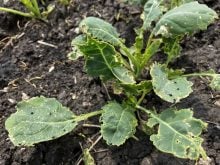Generating digital data has been a part of many farms for a few years, but only within the last couple have digital ag platforms flooded the marketplace.
A digital ag platform is software that allows farmers to generate meaningful information from equipment for crop scouting, farm management, soil mapping and record keeping. A lot of farmers are entering the digital ag sphere this year for the first time, my family’s farm included.
There’s no shortage of sales pitches for the latest and greatest in the technology. Because of this market saturation, the two instinctive questions that come to mind for me are: how does this make the farm more profitable and what problem are we solving?
Read Also

Growing garlic by the thousands in Manitoba
Grower holds a planting party day every fall as a crowd gathers to help put 28,000 plants, and sometimes more, into theground
I spoke with Lori Yarnell, climate business manager with Climate FieldView, to answer a few of my own questions about digital ag platforms, which I thought I’d share with Western Producer readers.
In terms of problem solving, Yarnell emphasizes that Climate Fieldview is solving a two-fold problem.
“Firstly, many farms are already generating a tremendous amount of data, so we’re solving the challenge of getting that data into one place. Secondly, we are translating that data into a usable format that enables farmers to make informed decisions.”
Farming is full of decisions, whether it’s annual cropping and rotational decisions or the daily logistics of spraying and scouting.
“Climate Fieldview’s live rainfall notification is useful for planning daily operations,” Yarnell said.
“Or after the season is over, a farmer may be looking to map the effects of sprayer speed on fungicide efficacy and whether there was a difference on parts of the field where he drove five m.p.h. faster than his/her normal spraying speed.”
In addition to tracking field operations, digital ag platforms provide an avenue for farmers to better organize fertility trials and test strips, measure soil variability or merge maps between equipment.
With dozens of digital ag platforms out there, how do farmers know which platform will best serve their needs? Yarnell draws a parallel between cellphone devices and digital ag technology.
“Similar to your cellphone, most people don’t fully utilize the capabilities of their device and often only use three or four specific features or applications. Farmers should pick a software that has one or two features that provide value for decision making or problem solving for their specific needs.”
She feels that it’s important to start simple and then extract value from additional features as users get comfortable with the platform.
“If the platform isn’t easy to use from the beginning, you’re not likely to use it afterwards.”
She warns that purchasing a software platform doesn’t guarantee a return on investment, and far too often farmers fall victim to assuming their investment will make them money without putting effort into utilizing various applications.
According to Yarnell, the greatest barrier to fully maximizing capabilities of a digital ag platform is fear of the time commitment involved, followed by apprehension or fear of a brand-new technology on the farm. Additionally, having previous negative experiences with data software often leaves growers unconvinced of the value to their farm.
“The more time that is put into learning the functions and capabilities of a software, the greater potential value and return on that investment.”
Yarnell said good software also makes uploading previous years data and sharing data simple and accessible.
“Farming is team sport, so sharing data with an agronomist or adviser can also be helpful for expert advice on decisions.”
Growers often raise concerns about data ownership, and according to Yarnell, the level of trust depends on the grower, so systems need to be science based.
“We have a robust team that handles the soil science, atmospheric data, statistics and computer science that goes into this software program.”
Yarnell said that while Climate Fieldview is designed to provide farmers with personalized insights powered by data science, machine learning capabilities needs to be used as well.
“The data that the program translates is only as good as the information going in.”
While it may seem intimidating for farmers to add yet another screen to their sprayer, seeder and combine, good information is an essential component of good decision making. What’s important is being aware of the potential return on investment that a digital ag platform can provide by helping a farmer make better short and long-term decisions on the farm.
Katelyn Duncan PAg is a farmer and agrologist from the Regina Plains. You can reach her through Twitter @FrmerAtHerTable or by at email newsroom@producer.com.

















